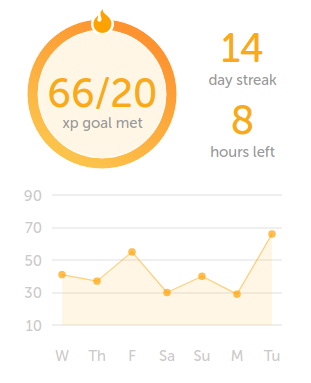Review: Duolingo
Founded in 2009 by Luis von Ahn of reCAPTCHA fame, Duolingo has quickly become the most popular free language learning tool, reaching some 150 million users today. Is it any good? The short answer: yes, but if you’re serious about learning a language, use it in combination with other resources.
After you sign up, the core experience is a set of interactive exercises focusing on different areas of a language: basic vocabulary, sentence structure, past and future verb tenses, and so on. Learning takes place along a sequential path, but you’re encouraged to repeatedly practice previous lessons.
Standard exercises include
-
practicing vocabulary using photographs (sort of like flash cards)
-
translating sentences in either direction
-
writing down what you hear
-
multiple choice quizzes of the “pick the correct translation(s)” variety
-
speaking sentences in the language you’re learning (the automatic validation errs on the side of marking your pronunciation correct)
This variety keeps the lessons interesting, though even after months of use, I still sometimes translate when I’m supposed to be transcribing. The mobile app minimizes the amount of typing by letting you “tap together” sentences rather than writing them, easing the difficulty a bit in favor of keeping things user-friendly.
One huge plus is that Duolingo is generally pretty good at accepting multiple translations for the same phrase. Sure, users still complain about correct translations not being accepted, but compared with language learning applications I’ve tried in the past, it handles the very large solution space pretty well, at least in Spanish.
Speaking of user comments, every exercise is linked to a discussion forum, which often contains helpful tips, both from other learners and native speakers.

A typical Duolingo lesson will include translation exercises like this one. The UI is streamlined so you never really get stuck — you can always quickly refresh your memory through built-in hints.
Duolingo is well-funded and its product designers and engineers routinely launch new experimental features. For example, as of this writing, the “Labs” section features Duolingo Stories, which are interactive, spoken short stories where you complete sentences as you go. The iOS app, meanwhile, is currently experimenting with chatbots.
This is all well and good, but the core product isn’t receiving nearly as much love. Aside from the exercises, there’s very little context that helps you to learn about grammar or the internal patterns of the language you’re learning. Some lessons include some instructive text, which tends to be both minimal and not very well-written. And once you’re done with the lessons (which, for Spanish, took me a few months), you’re still at very limited proficiency with nothing else to do but to practice or to try more “Labs” projects.

Gamification is a core part of the Duolingo user experience. The site tracks your daily usage, rewards you for completion of lessons, and sends you (genuinely helpful) reminders to keep at it.
On the positive side, the gamification — daily reminders, XP scores, levels, gemstones, etc. — does work to develop a language learning habit. Even aspects that may seem excessively silly (the mobile app lets you dress the Duolingo mascot in fancy clothes with the gemstones you’ve earned) do increase the user’s emotional investment in the learning process.
The business model is advertising (earlier plans to monetize translations notwithstanding), and the company has so far generally maintained a “not evil” reputation. You can even turn off the ads by paying a monthly fee, though most users will probably not find that to be worth it. With a high valuation and repeated injections of huge amounts of funding, let’s hope Duolingo continues to follow the straight and narrow.
I recommend Duolingo wholeheartedly — just don’t expect that it’ll be enough to get you from novice to pro. Use it in combination with books, videos, or free courses like Language Transfer. If you live in a big city, face-to-face Meetup groups can also be a great way to find other language learners and native speakers.